
La Seu d'Urgell is a town located in Alt Urgell county in Alt Pirineu, Catalonia, Spain. The town is also the head of its judicial district and the seat of the Bishop of Urgell, one of the co-princes of Andorra. It is located the most populated town of the region, with 17.4% of its population. La Seu d'Urgell and Puigcerdà together have 30% of the population of the area.

The County of Urgell is one of the historical Catalan counties, bordering on the counties of Pallars and Cerdanya.

The Diocese of Urgell is a Latin Church diocese of the Catholic Church in Catalonia (Spain) and the Principality of Andorra in the historical County of Urgell, with origins in the fifth century AD or possibly earlier. It is based in the region of the historical Catalan County of Urgell, though it has different borders. The seat and cathedral of the bishop are situated in la Seu d'Urgell town. The state of Andorra is a part of this diocese.

This is a list of the counts of Urgell, a county of the Principality of Catalonia in the 10th through 13th centuries.

Borrell II was the count of Barcelona, Girona and Ausona from 945 and count of Urgell from 948.

The Cathedral of St. Mary of la Seu Vella is the former cathedral church of the Roman Catholic Diocese of Lleida, in Lleida, Catalonia, Spain, located on top of Lleida hill.
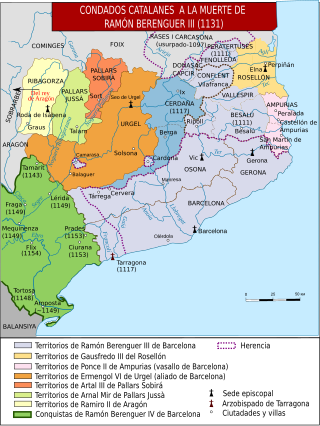
Ermengol or Armengol VI, called el de Castilla, was the count of Urgell from 1102 until his death. He was the son and successor of Ermengol V and María Pérez, daughter of Count Pedro Ansúrez, Lord of Valladolid, who became the young Ermengol's tutor when he was orphaned in 1102.
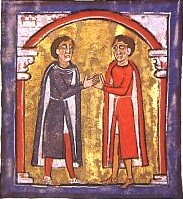
Ermengol or Armengol III, called el de Barbastro, was the Count of Urgell from 1038 to his death. He was the son of Ermengol II, Count of Urgell and his wife Velasquita "Constança", probably the daughter of Bernard I, Count of Besalú.
Artau I was the Count of Pallars Sobirà from 1049 until his death in or around 1081. His reign was characterised by ceaseless wars and litigations with his more powerful cousin and neighbour Raymond IV of Pallars Jussà.

Bernard I, called Taillefer, was the Count of Besalú in Catalonia from 988 until his death. He was the eldest son of Oliba Cabreta and Ermengard of Empúries, and succeeded his father in Besalú while his younger brothers Oliba and Wifred, inherited Berga–Ripoll and Cerdagne–Conflent, respectively. He was the great-grandson of Wilfred the Hairy, and therefore belonged to the House of Barcelona.
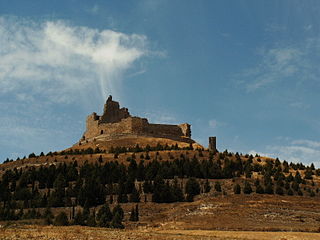
Nuño Pérez de Lara was a Castilian nobleman, politician and military leader. He began his career at the court of the Emperor Alfonso VII, during whose reign he took part in the repoblación of the Extremadura and the defence of the Almohad frontier. Between 1164 and 1169 he governed Castile as regent for the underage Alfonso VIII, and he continued to exercise semi-regal power in the kingdom until 1176. He founded two monasteries and fostered the cult of Thomas Becket in Spain. He died taking part in the conquest of Cuenca

Valbuena Abbey is a former Cistercian monastery in Valbuena de Duero in Valladolid Province, Castile-Leon, Spain. It stands on the right bank of the Duero, within sight of the royal castle of Peñafiel.
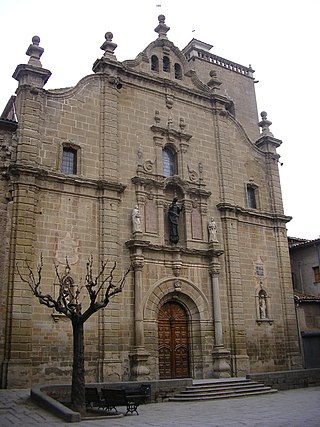
Guissona is a town and municipality located in the north of the comarca (county) of Segarra, in the Province of Lleida, Catalonia, Spain. With 6,862 inhabitants Guissona is the principal municipality in the northern half of Segarra and the second most populated in the county after Cervera. In addition to the populated place of Guissona, the municipality integrates the smaller place of Guarda-si-venes. The municipality is split into two parts, the bigger eastern part containing almost all the population.
Pedro Fernández de Castro, also known as Pedro Fernández de Fuentecalada, was the first Grand Master of the Order of Santiago and the founder of the Monastery of Santa Cruz de Valcárcel. He was a Spanish nobleman and a member of the House of Castro.

Sant Serni de Tavèrnoles is a Romanesque Benedictine monastery in Anserall, in the municipality of Les Valls de Valira, Alt Urgell, in the Province of Lleida, Catalonia, Spain. It became a Bien de Interés Cultural site on 3 June 1931 and was restored in 1971.
Álvaro Pérez de Castro "the Castilian" was a Castilian nobleman.

Sancha Ramírez was an Aragonese princess, the daughter of King Ramiro I and Queen Ermesinda. She was the countess of Urgell from c.1063 until 1065 as the wife of Count Ermengol III. Her brothers Sancho Ramírez and García Ramírez became king of Aragon and bishop of Pamplona, respectively. During her brother's reign she played an important role in consolidating the Kingdom of Aragon, which had been founded by her father in 1035.
The Battle of Mollerussa took place in the south of the county of Urgell on 11 or 14 September 1102. In the battle, Count Ermengol V was defeated and killed by an Almoravid army. Mollerussa lies halfway between Bellpuig and Lleida and is the largest town in the Pla d'Urgell.
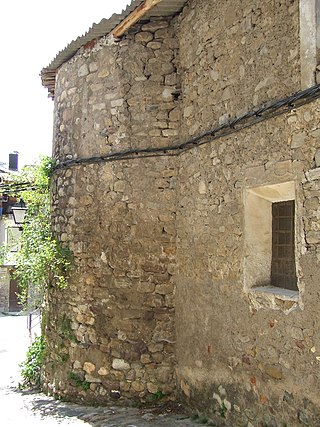
Posidonius was the bishop of Urgell in northern Spain between 814 and 823. He may have become bishop as early 803, the last year when Archbishop Leidrad was still clearly in control of the diocese following the ouster of Bishop Felix for heresy.
Sisebut was bishop of Urgell from 823 until his death.
















